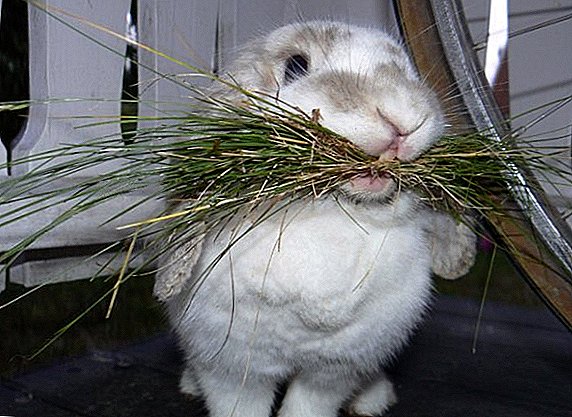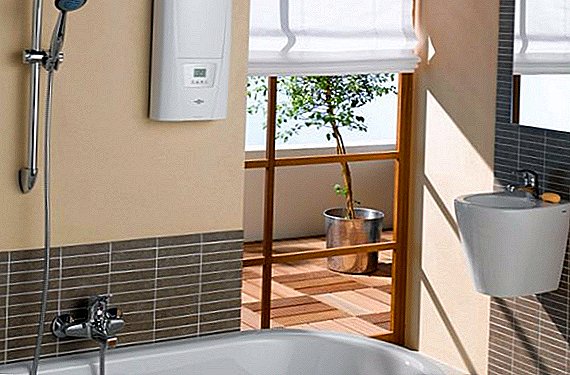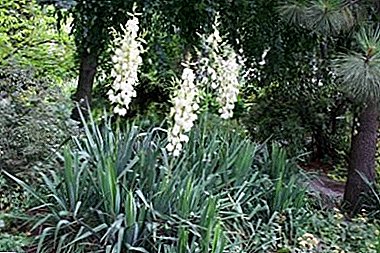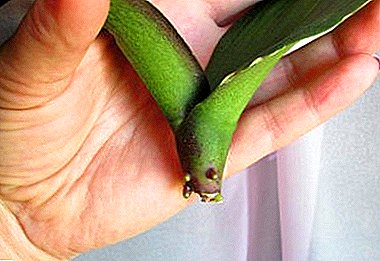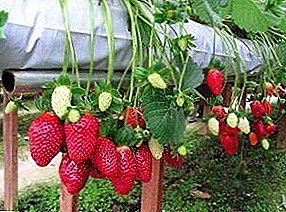 A mother rabbit is needed for successful breeding of offspring, and there is a need for it not only during the cold season, but also in the summer. Such a secluded place imitates the natural habitat of rabbits, namely the burrows in which they nurse their offspring. Recreating such conditions in the cage will allow the rabbits to better look after the little rabbits, and the cubs to grow strong and healthy. Features of the manufacture and use of this design will consider in the article.
A mother rabbit is needed for successful breeding of offspring, and there is a need for it not only during the cold season, but also in the summer. Such a secluded place imitates the natural habitat of rabbits, namely the burrows in which they nurse their offspring. Recreating such conditions in the cage will allow the rabbits to better look after the little rabbits, and the cubs to grow strong and healthy. Features of the manufacture and use of this design will consider in the article.
Rabbit nest: dimensions and features
At home, you can recreate the rabbit hole with your own hands by building a special box with a hole in which the bunny will nurse the cubs. Make such a box is not difficult and not expensive. It is a warmed box with plywood walls, opening top for easy cleaning and with a round hole on the side, which is a hole for the bunny.  Despite the fact that rabbits come in different sizes, mothers usually do the standard. Large dimensions are necessary only if animals belong to very large breeds. However, the majority of representatives will approach the standard size of the structure.
Despite the fact that rabbits come in different sizes, mothers usually do the standard. Large dimensions are necessary only if animals belong to very large breeds. However, the majority of representatives will approach the standard size of the structure.
Learn how to make a cage for rabbits, a shed, a barn, a cottage, a water bowl, a feeding trough and a sennik.
The standard box for the rabbit has the following dimensions:
- bottom area - 30x50 cm;
- front and back walls - 30x50 cm;
- side walls - 30x35 cm;
- height of all walls - 30 cm;
- diameter of a round manhole - from 15 cm to 18 cm.
 The rabbit's nest is necessarily equipped with a round hole - a manhole, through which the animal will climb inside. The manhole is made laterally on the front wall of the drawer, retreating from the side wall of 1-2 cm. The walls of the construction are double, with a well-packed layer of sawdust in the niche between the plywood: this allows you to effectively keep warm in the nest. For the same purpose, a layer of dry and warm bedding is poured at the bottom of the box.
The rabbit's nest is necessarily equipped with a round hole - a manhole, through which the animal will climb inside. The manhole is made laterally on the front wall of the drawer, retreating from the side wall of 1-2 cm. The walls of the construction are double, with a well-packed layer of sawdust in the niche between the plywood: this allows you to effectively keep warm in the nest. For the same purpose, a layer of dry and warm bedding is poured at the bottom of the box.Important! If the baby rabbit is awaited by a very young female, then the farmer needs to take care of the litter in the mother liquor. But adult rabbit independently equip and warm the nest for future offspring.To facilitate the task of cleaning the queen, as well as to ensure the ability to control the rabbits, watching them and not disturbing them, you can equip the top lid of the box with canopies, which will allow you to open the nest at any time and remove the nest . If the rabbits are too large and the nest made for them does not fit inside the cage, then it can be done simply by continuing the cage, with its additional insulated compartment.
Choosing wood for the queen, you should not opt for conifers: they have a persistent smell of essential oils, which most likely will scare the bunny. Because of this, she can both abandon the nest, and stop altogether caring for offspring. As for the manhole, you should not place it too high. It must be borne in mind that not only the adult female will crawl through it, but also the little rabbits, when the time comes to leave the nest. 
How to make a design with your own hands
Making a nest for the rabbit with their own hands is quite economical both in time and in terms of the effort and financial costs. The design, made by hand, has a number of advantages over production analogues, as it is characterized by mobility (manufacturers usually make queen cells already embedded in the cage) and corresponds to the needs and sizes of your animals.
Did you know? Rabbits become able to conceive after six months of life, and during the year, females, on average, produce about 30 new litters. A record is known when the female bore 24 cubs at once.
Required materials and tools
For the manufacture of the box, which will serve as a nest for the rabbit, you will need the following materials:
- plywood sheets up to 5 mm thick, 2 pcs. each on each side - 4 pcs. with dimensions of 30x50 cm for the front and rear walls; 4 things. with dimensions of 35x50 cm for the bottom and the cover and 4 pcs. with dimensions of 30x35 cm for the side walls;
- wooden slats 2-2.5 cm thick;
- wooden boards up to 3 cm thick;
- sheds - two small or one large;
- insulation in the form of sawdust.
 In order to make a nest out of these materials, you will need the following tools:
In order to make a nest out of these materials, you will need the following tools:
- tape measure and pencil or chalk for measuring and scribbling;
- hammer;
- hacksaw;
- screws and nails for fastening structures;
- screwdriver or screwdriver.
Did you know? Despite the fact that the peak activity of rabbits falls at sunrise or sunset, these animals are perfectly oriented in the dark. Therefore, small rabbits do not need to illuminate the nest.
Instructions for making
Making a nest for the rabbit begins with the preparation of drawings and cutting plywood and slats according to them. Further actions are as follows:
- Each sheet of plywood must be nailed around the perimeter of the nails slats. This is done with all sheets, except those two that are designed for the future manhole. The slats should correspond exactly to the length of the plywood sheets and fit snugly to each other, otherwise the sawdust will wake up through the slots and may be dangerous for the rabbits.
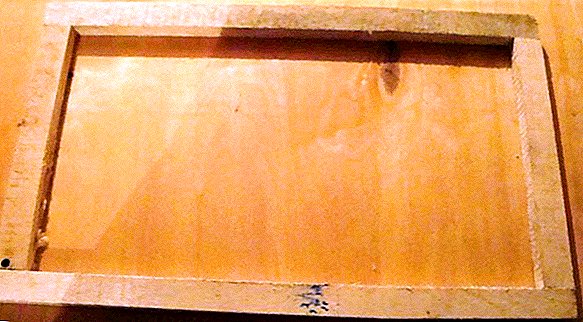
- In the resulting frame fall asleep sawdust. They need to be tamped well and fall asleep very tightly. If you ignore this rule and do not compress the sawdust, then during operation they will stray, which will adversely affect the efficiency of the insulation.
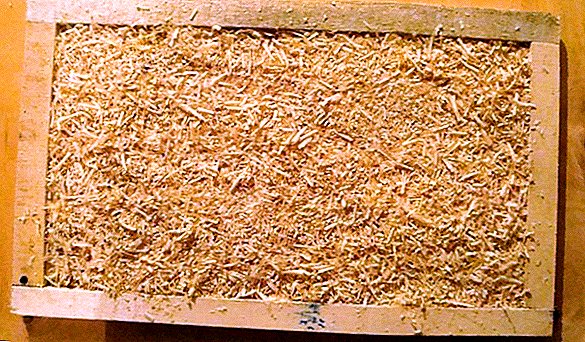
- After the frames were filled with insulation, they must be sheathed with a second sheet of plywood on the open side. In this way, solid finished parts are obtained.
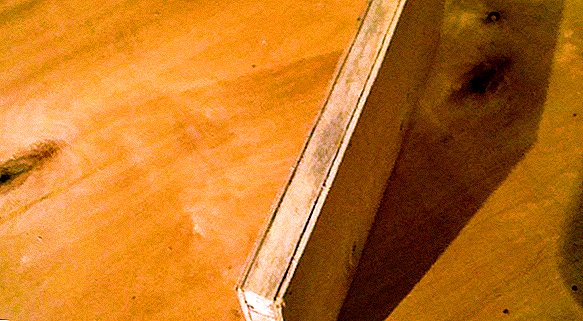
- Now you can do the front wall, which will have a hole for the rabbit. This wall is made differently and is a national team. So, one of its parts, the one in which the hole will be, should consist of a board in which a hole is cut, and the second part is made up of rails, sheathed with plywood and filled with insulation, like the rest of the construction. Both parts of the front wall are fastened together.
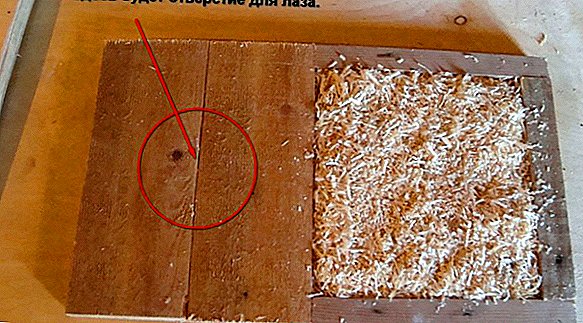
- Laz can be cut with a jigsaw, but if there is none, then an ordinary hacksaw is suitable for this purpose. In addition, the hole for the rabbit does not necessarily make it round, if this does not work. You can just cut a square hole with a hacksaw at the side of the wall. The main thing is that it should be of such a size that the rabbit could crawl into it and the heat would not leave the space of the queen faster than necessary.
- All finished parts are assembled and fastened with nails or screws so that the box is obtained, but the lid is not attached yet.

- It is best to make the lid openable, therefore using screws to fasten the sheds to the upper edge of the back wall, on which they put the part.
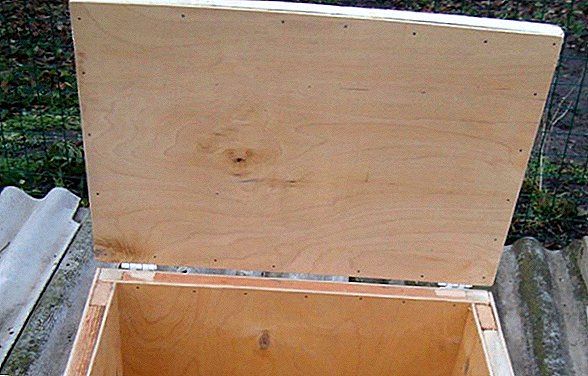
Its size is matched to the size of the internal space of the box. It is enough to put such a heating pad on the bottom of the box, cover it with a cloth and cover with straw: the rabbits will feel comfortable on a warm floor. You can turn on the heating pad as needed. You can also use modern methods of heating - for example, to make a heated floor with a film with special built-in heating elements placed under the queen cell.
Important! In order not to overheat the rabbits, in the mother liquor it is necessary to set the minimum power of the heating devices, and it should be in the range from 100 W to 150 W per square meter. meter.
Slats up to 2 cm thick are installed around the perimeter, on top of which the box is placed. Thus, a warm air cushion arises between the film and the bottom of the mother liquor. It is possible to warm the nest for rabbits for the winter without using electric heating devices. To do this, it is enough to lay the outside of the box with sheets of foam, and inside put a heating pad or a bottle of hot water.  And although this method is absolutely safe for rabbits, it is rather troublesome, as it is necessary to regularly monitor the temperature of the water in the heaters and constantly change it. If there are many rabbits, then this method is not very profitable. The mother liquor in the winter time must be equipped with a thermometer or electric heaters with automatic thermoregulation, because overheating is very bad for both adult rabbits and babies.
And although this method is absolutely safe for rabbits, it is rather troublesome, as it is necessary to regularly monitor the temperature of the water in the heaters and constantly change it. If there are many rabbits, then this method is not very profitable. The mother liquor in the winter time must be equipped with a thermometer or electric heaters with automatic thermoregulation, because overheating is very bad for both adult rabbits and babies.
Using the nest for the rabbit
The queen cell is installed in a cage with a pregnant rabbit about 5 days before the intended delivery - it is necessary that she build a nest inside the box. The rabbit lays the bottom with straw, as well as with scraps of his own wool, which he plucks from his chest and abdomen. The fact that childbirth will be soon, can be understood by the behavior of the female - she becomes aggressive and restless, rushes around the cage, makes attempts at arranging the nest. Pre-installation of the queen will allow the animal to get used to it, to sniff it, and if the female finds the box cozy and safe, then she will begin to nest in it.  Although sometimes young females can begin to drag litter into the nest after the bow. In this case, you can first help the inexperienced mother and partially arrange the nest yourself. In order for the rabbit to not refuse the queen, it should not contain extraneous odors, should be dry and warm, protected and comfortable. However, without the urgent need for it, it is not necessary to climb into the nest and too often look under the opening lid, otherwise the female will feel uncomfortable and may refuse the box. Additional lighting is not necessary: rabbits feel great in the dark, and rabbits are born in dark burrows and at first do not need lighting.
Although sometimes young females can begin to drag litter into the nest after the bow. In this case, you can first help the inexperienced mother and partially arrange the nest yourself. In order for the rabbit to not refuse the queen, it should not contain extraneous odors, should be dry and warm, protected and comfortable. However, without the urgent need for it, it is not necessary to climb into the nest and too often look under the opening lid, otherwise the female will feel uncomfortable and may refuse the box. Additional lighting is not necessary: rabbits feel great in the dark, and rabbits are born in dark burrows and at first do not need lighting.
Important! Adult rabbits feel comfortable at 0. And at a constant temperature, which does not drop below the mark of + 10 животные, animals are gaining weight well and feel good. However, newborn babies need a higher temperature, which should be between + 26 + and + 28.
Rabbits are pretty responsible mothers, so they take care of the babies themselves and usually they do not need any additional human intervention. Although rabbits usually do not breed in winter because of cold weather, but at home, when animals maintain a stable warm temperature, we can expect replenishment at any time.
Therefore, for winter, warmed queen cells are necessary, but the temperature regime in them must be controlled so that the rabbit does not have overheating. In the warm season heating in the box is no longer needed. Cleaning should be done regularly in the nest.
Get acquainted with the peculiarities of winter around with street content.
The litter needs to be changed as it gets dirty and to prevent the accumulation of moisture and excrement on the wooden bottom of the box, otherwise the plywood may begin to rot, which will violate the thermal insulating properties of the structure and will become the source of reproduction of pathogenic bacteria. It is not necessary to push the rabbits to leave the mother liquor. The first 20 days of the rabbit will be with them in the nest, but then she and the offspring will independently leave a kind of "hole" and come out.  The size of the queen is important for the rabbit, because in a too small box she will be uncomfortable, and she will perceive too large as another cage and will defecate there. But the little bunnies will relieve themselves in the nest. Therefore, to protect the bottom of plywood from rotting due to urine and excrement, it is possible to lay galvanized sheets on the bottom. But with this you need to be careful in the winter, because iron has a high thermal conductivity, which is why the temperature in the mother liquor will drop greatly.
The size of the queen is important for the rabbit, because in a too small box she will be uncomfortable, and she will perceive too large as another cage and will defecate there. But the little bunnies will relieve themselves in the nest. Therefore, to protect the bottom of plywood from rotting due to urine and excrement, it is possible to lay galvanized sheets on the bottom. But with this you need to be careful in the winter, because iron has a high thermal conductivity, which is why the temperature in the mother liquor will drop greatly.
You can protect yourself from this by placing a thick layer of straw at least 20 cm above the sheets. When you equip the nest with heating devices, you need to be concerned about the complete isolation of all elements from accessing the rabbits. Wires must be brought out of the cage, otherwise the rabbits are likely to be gnawed, and all parts of the heaters must be protected from moisture, urine and animal excrement, otherwise in the opposite case this may lead to a short circuit and fire.
Did you know? A bunny rabbit can simultaneously harbor two litters from different males and conceived at different times. This is possible because females of this animal species have a split uterus.
Mother Rabbit - a design that is easy and cheap to make yourself. It is made from scrap materials, practically does not require financial and time costs, and for animals it serves as a reliable shelter, provides them with a sense of security, and in winter it serves as a necessary heating for bare and defenseless rabbits.








